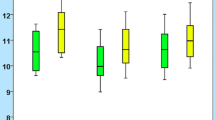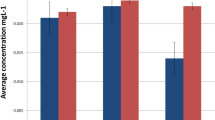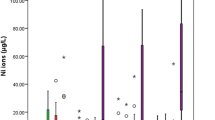Abstract
Objective
Orthodontic appliances are considered to be highly biocompatible although adverse effects attributed to the release of nickel ions (Ni2+) have been documented. Self-ligating brackets have grown in popularity for economic reasons and supposed friction reduction. The aim of the present prospective cohort study was therefore to determine salivary Ni2+ concentrations in patients undergoing orthodontic treatment with self-ligating fixed appliances.
Materials and methods
A group of 30 patients between 10 and 13 years of age were treated with self-ligating brackets (SmartClip™), molar bands, and nickel–titanium (NiTi) archwires. Unstimulated saliva samples were collected after different time points (before treatment, after self-ligating bracket and band placement, before archwire insertion, after archwire insertion, and finally 4 and 8 weeks afterwards) and analyzed with an ICP mass spectrometer followed by generalized estimating equation modelling with α = 5 %.
Results
The baseline median salivary Ni2+ concentration was 21.85 µg/l, while the Ni2+ concentrations at the following visits ranged between 13.73 and 85.34 µg/l. Significant increases in Ni2+ levels compared to the baseline levels were detected after band/bracket placement [+59.76 µg/l; 95 % confidence interval (CI) 44.88–74.64 µg/l; P < 0.001] and after archwire insertion (+53.55 µg/l; 95 % CI 25.57–81.52 µg/l; P < 0.001). After 4 weeks, Ni2+ concentrations returned to initial control levels or were lower.
Conclusion
Self-ligating orthodontic appliances may affect salivary Ni2+ concentrations in vivo over the short term. However, levels resembled those documented in conjunction with conventional bracket use and remained below the daily dietary Ni intake.
Zusammenfassung
Hintergrund und Ziel
Im Allgemeinen werden kieferorthopädische Apparaturen als hoch biokompatibel eingeschätzt, obwohl verschiedene Nebenwirkungen bedingt durch die Freisetzung von Nickelionen (Ni2+) dokumentiert wurden. Selbstligierende Bracketsysteme erfreuen sich zunehmender Beliebtheit aufgrund wirtschaftlicher Aspekte und propagierter Friktionsreduktion. Ziel der vorliegenden prospektiven Kohortenstudie was es daher, die Ni2+-Konzentrationen im Speichel von Patienten zu bestimmen, die einer Behandlung mit selbstligierenden festsitzenden Multibracketapparaturen unterzogen wurden.
Material und Methodik
Dreißig Patienten im Alter von 10–13 Jahren wurden mit selbstligierenden Brackets (SmartClip™), Molarenbändern und Nickel-Titanium-Bögen behandelt. Unstimulierte Speichelproben wurden nach unterschiedlichen Zeitpunkten (vor Behandlung, nach Insertion selbstligierender Brackets/Bänder, 2 Wochen nach und direkt vor Bogeninsertion, direkt nach Bogeninsertion, 4 und 8 Wochen nach Bogeninsertion) gesammelt und mittels ICP(“inductively coupled plasma”)-Massenspektrometer analysiert. Die Daten wurden mittels eines verallgemeinernden Schätzgleichungsmodells mit einer Signifikanzgrenze von 5 % ausgewertet.
Ergebnisse
Der Medianwert der Ni2+-Konzentrationen im Speichel vor der Behandlung (Referenzwert) lag bei 21,85 µg/l. In den folgenden Sitzungen lagen die Ni2+-Werte zwischen 13,73 und 85,34 µg/l. Ein signifikanter Anstieg der Ni2+-Konzentrationen im Vergleich zum Referenzwert wurde nach der Insertion der selbstligierenden Brackets und Bänder (+59,76 µg/l, 95 %-Konfidenzintervall, KI: 44,88–74,64 µg/l; P < 0,001) und nach Bogeninsertion (+53,55 µg/l; 95 %-KI: 25,57–81,52 µg/l; P < 0,001) ermittelt. Nach 4 Wochen waren die Ni2+-Werte wieder auf dem Referenzniveau bzw. niedriger.
Schlussfolgerung
Die Daten lassen die Schlussfolgerungen zu, dass selbstligierende Multibracketsysteme die Ni2+-Konzentrationen im Speichel in vivo kurzfristig beeinträchtigen. Dennoch lagen die Konzentrationen in Höhe der bei Behandlung mit konventionellen Multibracketsystemen ermittelten Werte sowie unterhalb der täglichen Nickelaufnahme durch die Nahrung.





Similar content being viewed by others
References
Andreasen GF, Hilleman TB (1971) An evaluation of 55 cobalt substituted Nitinol wire for use in orthodontics. J Am Dent Assoc 82:1373–1375
Ağaoğlu G, Arun T, İzgü B et al (2001) Nickel and chromium levels in the saliva and serum of patients with fixed orthodontic appliances. Angle Orthod 71:375–379
Eliades T, Trapalis C, Eliades G et al (2003) Salivary metal levels of orthodontic patients: a novel methodological and analytical approach. Eur J Orthod 25:103–106
Fors R, Persson M (2006) Nickel in dental plaque and saliva in patients with and without orthodontic appliances. Eur J Orthod 28:292–297
Kerosuo H, Moe G, Hensten-Pettersen A (1997) Salivary nickel and chromium in subjects with different types of fixed orthodontic appliances. Am J Orthod Dentofac Orthop 111:595–598
Kerosuo H, Moe G, Kleven E (1995) In vitro release of nickel and chromium from different types of simulated orthodontic appliances. Angle Orthod 65:111–116
Kocadereli I, Ataç A, Kale S et al (2000) Salivary nickel and chromium in patients with fixed orthodontic appliances. Angle Orthod 70:431–434
Luft S, Keilig L, Jäger A et al (2009) In-vitro evaluation of the corrosion behavior of orthodontic brackets. Orthod Craniofac Res 12:43–51
Amini F, Rahimi H, Morad G et al (2013) The effect of stress on salivary metal ion content in orthodontic patients. Biol Trace Elem Res 155:339–343
Barrett RD, Bishara SE, Quinn JK (1993) Biodegradation of orthodontic appliances. Part I. Biodegradation of nickel and chromium in vitro. Am J Orthod Dentofac Orthop 103:8–14
Huang HH, Chiu YH, Lee TH et al (2003) Ion release from NiTi orthodontic wires in artificial saliva with various acidities. Biomaterials 20:3585–3592
Ehrnrooth M, Kerosuo H (2009) Face and neck dermatitis from a stainless steel orthodontic appliance. Angle Orthod 79:1194–1196
Kolokitha OE, Chatzistavrou E (2009) A severe reaction to Ni-containing orthodontic appliances. Angle Orthod 79:186–192
Costa M, Zhuang Z, Huang X et al (1994) Molecular mechanisms of nickel carcinogenesis. Sci Total Environ 148:191–199
Fernández-Miñano E, Ortiz C, Vicente A et al (2011) Metallic ion content and damage to the DNA in oral mucosa cells of children with fixed orthodontic appliances. Biometals 24:935–941
Gölz L, Bayer S, Ludger K et al (2014) Possible implications of Ni(II) on oral IL-1β-induced inflammatory processes. Dent Mater 30:1325–1335
Natarajan M, Padmanabhan S, Chitharanjan A et al (2011) Evaluation of the genotoxic effects of fixed appliances on oral mucosal cells and the relationship to nickel and chromium concentrations: an in vivo study. Am J Orthod Dentofac Orthop 140:383–388
Wataha JC, Lockwood PE, Marek M et al (1999) Ability of Ni-containing biomedical alloys to activate monocytes and endothelial cells in vitro. J Biomed Mater Res 45:251–257
Simonsen AB, Deleuran M, Johansen JD et al (2011) Contact allergy and allergic contact dermatitis in children—a review of current data. Contact Dermat 65:254–265
Gölz L, Papageorgiou SN, Jäger A (2015) Nickel hypersensitivity and orthodontic treatment: a systematic review and meta-analysis. Contact Dermat 73:1–4
Rietschel RL, Fowler JF, Warshaw EM et al (2008) Detection of nickel sensitivity has increased in North American patch-test patients. Dermatitis 19:16–19
Bass JK, Fine H, Cisneros GJ (1993) Nickel hypersensitivity in the orthodontic patient. Am J Orthod Dentofac Orthop 103:280–285
Schuster G, Reichle R, Bauer RR et al (2004) Allergies induced by orthodontic alloys: incidence and impact on treatment. Results of a survey in private orthodontic offices in the Federal State of Hesse, Germany. J Orofac Orthop 65:48–59
Fors R, Persson M, Bergström E et al (2012) Lifestyle and nickel allergy in a Swedish adolescent population: effects of piercing, tattooing and orthodontic appliances. Acta Derm Venereol 92:664–668
Schmidt M, Raghavan B, Müller V et al (2010) Crucial role for human toll-like receptor 4 in the development of contact allergy to nickel. Nat Immunol 11:814–819
Papageorgiou SN, Konstantinidis I, Papadopoulou K, Jäger A, Bourauel C (2014) Clinical effects of pre-adjusted edgewise orthodontic brackets: a systematic review and meta-analysis. Eur J Orthod 36:350–363
Sahoo N, Kailasam V, Padmanabhan S, Chitharanjan AB (2011) In-vivo evaluation of salivary nickel and chromium levels in conventional and self-ligating brackets. Am J Orthod Dentofac Orthop 140:340–345
Petoumenou E, Arndt M, Keilig L et al (2009) Nickel concentration in the saliva of patients with nickel titanium orthodontic appliances. Am J Orthod Dentofac Orthop 135:59–65
Petoumenou E, Kislyuk M, Hoederath H et al (2008) Corrosion susceptibility and nickel release of nickel titanium wires during clinical application. J Orofac Orthop 69:411–423
Selby M, Hieftje GM (1987) Inductively coupled plasma-mass spectrometry: a status report. Am Lab 19/16:16–28/28–40
Pan W (2001) Akaike’s information criterion in generalized estimating equations. Biometrics 57:120–125
Hogeling M, Pratt M (2008) Allergic contact dermatitis in children: the Ottawa hospital patch-testing clinic experience, 1996 to 2006. Dermatitis 19:86–89
Eliades T, Bourauel C (2005) Intraoral aging of orthodontic materials: the picture we miss and its clinical relevance. Am J Orthod Dentofac Orthop 127:403–412
Pandis N, Bourauel C, Eliades T (2007) Changes in the stiffness of the ligating mechanism in retrieved active self-ligating brackets. Am J Orthod Dentofac Orthop 132:834–837
Arndt M, Brück A, Scully T et al (2005) Nickel ion release from orthodontic NiTi wires under simulation of realistic in situ conditions. J Mater Sci 40:3659–3667
Matos de Souza R, Macedo de Menezes L (2008) Nickel, chromium and iron levels in the saliva of patients with simulated fixed orthodontic appliances. Angle Orthod 78:345–350
Papadopoulou K, Eliades T (2009) Microbiologically-influenced corrosion of orthodontic alloys: a review of proposed mechanisms and effects. Aust Orthod J 25:63–75
Maia LH, Lopes Filho H, Ruellas AC, Araújo MT, Vaitsman DS (2014) Corrosion behavior of self-ligating and conventional metal brackets. Dental Press J Orthod 19:108–114
Park HY, Shearer TR (1983) In vitro release of nickel and chromium from simulated orthodontic appliances. Am J Orthod Dentofac Orthop 84:156–159
Amini F, Jafari A, Amini P et al (2012) Metal ion release from fixed orthodontic appliances-an in vivo study. Eur J Orthod 34:126–130
Issa Y, Brunton P, Waters CM et al (2008) Cytotoxicity of metal ions to human oligodendroglial cells and human gingival fibroblasts assessed by mitochondrial dehydrogenase activity. Dent Mater 24:281–287
Schmalz G, Garhammer P (2002) Biological interactions of dental cast alloys with oral tissues. Dent Mater 18:396–406
Novak N, Gros E, Bieber T et al (2010) Human skin and oral mucosal dendritic cells as ‘good guys’ and ‘bad guys’ in allergic immune responses. Clin Exp Immunol 161:28–33
Dabeka RW, McKenzie AD (1995) Survey of lead, cadmium, fluoride, nickel, and cobalt in food composites and estimation of dietary intakes of these elements by Canadians in 1986–1988. J AOAC Int 78:897–909
Nielsen GD, Flyvholm M (1984) Risks of high nickel intake with diet. IARC Sci Publ 53:333–338
Staffolani N, Damiani F, Lilli C et al (1999) Ion release from orthodontic appliances. J Dent 27:449–454
Gjerdet NR, Erichsen ES, Remlo HE et al (1991) Nickel and iron in saliva of patients with fixed orthodontic appliances. Acta Odontol Scand 49:73–78
Author information
Authors and Affiliations
Corresponding author
Ethics declarations
Conflict of interest
Lina Gölz, Anna Christine Knickenberg,Ludger Keilig, Susanne Reimann, Spyridon N. Papageorgiou, Andreas Jäger, and Christoph Bourauel state that there are no conflicts of interest.
Additional information
Prof. Christoph Bourauel.
L. Gölz and A. C. Knickenberg contributed equally to this article.
Appendix: Protocol for the placement of the fixed orthodontic appliances
Appendix: Protocol for the placement of the fixed orthodontic appliances
Teeth were polished with pumice and rubber cup to remove pellicle and food debris and then rinsed with water and air dried. Preformed stainless steel bands (Ormco, Glendora, CA, USA) were fitted to the patients’ upper and lower first molars and cemented with glass-ionomer cement (Ketac Cem mu, 3 M ESPE, Seefeld, Germany). The buccal surfaces of the remaining teeth underwent acid etching (phosphoric acid 37 %, Ormco) for 15 s, rinsed again with water, and air dried. Monomer primer (bonding; Transbond XT, 3M Unitek, Monrovia, CA, USA) was applied on etched surfaces of the teeth followed by application of light cure composite resin (Transbond XT, 3M Unitek) on the bracket bases. Brackets (SmartClip™, 3M Unitek) were pressed lightly onto the tooth surface and material excess removed. Polymerization was done with a halogen lamp for 30 s per tooth.
Rights and permissions
About this article
Cite this article
Gölz, L., Knickenberg, A.C., Keilig, L. et al. Nickel ion concentrations in the saliva of patients treated with self-ligating fixed appliances: a prospective cohort study. J Orofac Orthop 77, 85–93 (2016). https://doi.org/10.1007/s00056-016-0012-x
Received:
Accepted:
Published:
Issue Date:
DOI: https://doi.org/10.1007/s00056-016-0012-x




